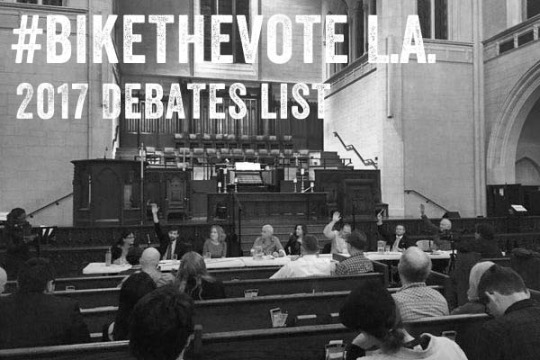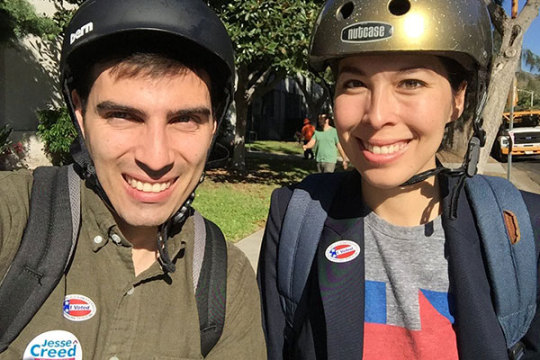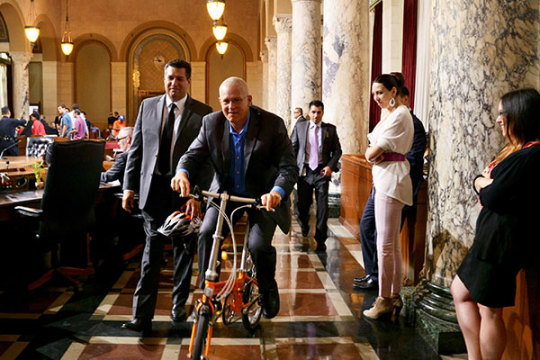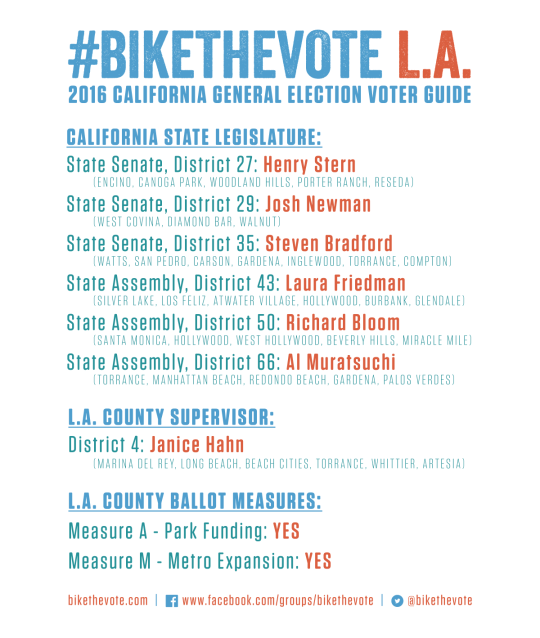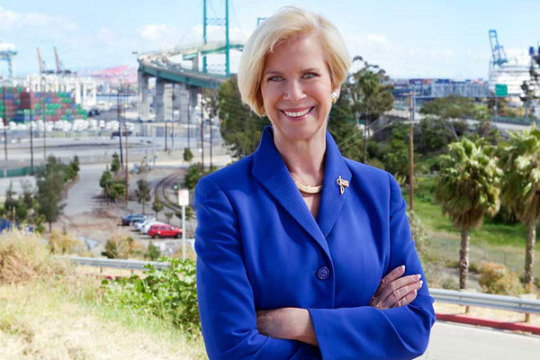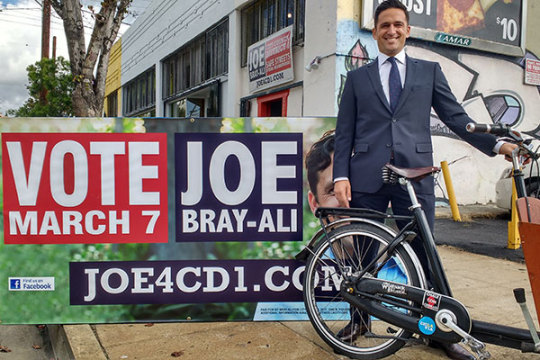
UPDATED: Bike The Vote L.A. has changed its position to no endorsement in the Los Angeles City Council District 1 race. Statement here: http://bit.ly/cd1rsnd
2017 Los Angeles CD1: No Endorsement
CD1 Run-Off Election day: Tuesday, May 16th, 7am-8pm
Find your Council District: http://neighborhoodinfo.lacity.org/
Find your polling place: http://lavote.net/locator
For the past decade, Joe Bray-Ali has been a fixture across Los Angeles, pedaling his bakfiets cargo bike from Northeast Los Angeles to the Westside, advocating for safer streets and better access for children to schools and parks. He led the first community group meeting to bring awareness to the pedestrian and bicycle safety needs of North Figueroa Street (later called “Figueroa for All”) at his bike shop Flying Pigeon in 2009. Since then, he has been a tireless spokesman for livable streets, voicing his concerns at City Hall and in various public forums, as well as organizing countless all-ages bike rides to encourage Angelenos to enjoy the benefits of traveling by two wheels. Now a candidate for City Council, Bray-Ali offers an approach informed not only by his organizing, but also by a focus on the importance of safe streets as a backbone for strong and connected communities.
L.A.’s 1st Council District, which Bray-Ali is seeking to represent, has had a tumultuous recent history. Four years ago, then-State Senator Gil Cedillo won a narrow victory in a hard-fought and often ugly battle for the CD 1 seat. During that campaign, Cedillo spoke enthusiastically about the role bicycling could play in creating a better transportation system. Not long after that campaign, however, Cedillo changed his position.
In 2014, Councilmember Cedillo notified residents that he had decided to halt to a shovel-ready street safety project on North Figueroa Street that included bike lanes. In 2015, Cedillo was one of two city councilmembers to vote ‘No’ on Mobility Plan 2035, citing a concern over increased traffic as a reason not to provide safe, convenient alternatives to driving. We may never get a straight answer regarding Cedillo’s change of heart, but it is unfortunate considering that most of the people in harm’s way on CD 1 streets are low-income and immigrant workers without access to cars — some of the same vulnerable residents that Cedillo spent much of his state legislative tenure working to protect.
A regular lack of responsiveness to local concerns by Councilmember Cedillo’s office has spurred a number of challengers in the race to serve the 1st District
(note: Councilmember Cedillo’s campaign did not respond to a Bike The Vote L.A. questionnaire). Among them, both Giovany Hernandez and Joe Bray-Ali offered thoughtful and encouraging responses to Bike The Vote L.A.’s questionnaire (Update: Of the candidates who responded to Bike The Vote L.A., only Bray-Ali has progressed to the May 16th run-off). As a bike mechanic-turned-bike co-op founder-turned-bike shop owner-turned-safe streets advocate-turned-political candidate, Bray-Ali’s knowledge of transportation issues in CD 1 is unparalleled.
Through Bray-Ali’s transformation from community advocate to candidate for elected office, we’ve gotten a window into the local election process, as well as Bray-Ali’s own evolution in engaging on a wide spectrum of important issues. We appreciate Bray-Ali’s community-centric approach to governance, which will be important as he works to solve problems and meet challenges throughout the District. In order to ensure bike, pedestrian and transit facilities are implemented effectively, Bray-Ali will need to work with a diverse range of mobility advocates like LACBC, Multicultural Communities for Mobility, and Los Angeles Walks. He’ll also need to engage community members, tenant rights groups, and social justice organizations to ensure that existing residents from Highland Park to Pico-Union are able to make use of quality of life improvements that are long overdue to their communities.
As Los Angeles moves forward as a leader on immigrant rights and as a defiant sanctuary city under a racist Trump administration, the need to work together to protect and improve the lives of all residents – especially immigrants – becomes that much more critical. We appreciate Bray-Ali’s commitment to elevate community voices as a necessary change from the norm. Knowing that his hands-on approach will lead to supporting a stronger community, Bike The Vote L.A. endorses Joe Bray-Ali for City Council District 1.
(See below for Joe Bray-Ali’s response to Bike The Vote L.A.)
1. What future do you see for active mobility, and public transit in the daily lives of Angelenos, particularly those who lack access to cars and rely on these other modes as their primary way of getting around?
This is really two questions. First, the future if we continue on our current path, and second, how I would change things if elected.
If we were to continue as we are, the 1st Council District will remain a collection of broken links between work, school, and home for people walking, riding bikes, or taking transit. Sadly, this path will result in less commerce, more collisions and more lives lost due to a lack of street safety.
If elected, I would act immediately to fund and implement the numerous completed plans to improve conditions for pedestrians, cyclists, and transit users (e.g. North East Linkages Plan, 2010 Los Angeles Bike Plan the 2008 Making the Connections plan by Metro, and others). My vision for the 1st Council District is that of a multi-modal, bike- and walk-friendly, region linking the San Gabriel and San Fernando Valleys with the Los Angeles Basin where safety and user experience are prioritized.
2. A high percentage of people without access to cars in Northeast Los Angeles, especially immigrants, depend on bikes as a way to get to work and school, but lack safe options to commute. Additionally the prevalence of speeding on L.A. streets takes a deadly toll on those who walk and bike, including seniors and children. Mobility Plan 2035 established “safety first” as the priority in transportation decisions, and the City has since adopted the ‘Vision Zero’ program with the goal of eliminating traffic-deaths within 10 years. Do you support prioritizing the safety of Los Angeles’ most vulnerable commuters, both in CD1 and throughout Los Angeles, even when there may be trade-offs in terms of automotive travel time or on-street parking?
I am committed to eliminating traffic deaths. I founded a community group, Fig4All, in 2013 with neighbors to work towards a safer North Figueroa Street. I have hosted forums, protests, rides, rallies, meetings, written op-eds, spoken publicly in City Hall and elsewhere, and have been interviewed by local and national media about my position on re-orienting Los Angeles towards the needs of the person on foot, on a bicycle, or using transit. The 1st Council District boasts some of the highest walking and transit commuter modal splits in the city (particularly in the MacArthur Park and Chinatown areas).
There very well may be trade-offs required to make the city friendlier to active transportation users. As a veteran of the bruising 2010 LA Bike Plan process and implementation, I am prepared to make those trade-offs – but only after taking robust feedback from the public, and only after we’ve set metrics to check whether or not a given design or device is performing to our expectations.
I am ready to work with everyone interested in making our streets safer and more productive, and I am committed to Vision Zero.
3. Los Angeles’ traffic woes are compounded by the reality that many parents and workers don’t feel safe commuting even short distances or performing school drop-offs on foot or by bike. What would you do as Councilmember to improve active transportation options around schools, public transit, and in commercial districts to provide better transportation options for CD1 residents?
As a small business owner, a parent, and an activist for safe streets I have several proposals that address improving active transportation around school, transit, and our commercial districts (and parks!).
At my small bike shop, we have benefitted from a series of small interventions – a neighboring business installed movable planters on the sidewalk in front of our building and a bench under a large tree. These small, privately funded, efforts to orient the street towards pedestrians and to make our noisy, slightly run-down, block appear attractive and safe have meant we enjoy a slow, but steady, trade from people passing by on foot. Two blocks aways, a small business owner has tried something similar but has had his efforts to provide shade at a bus stop and a tiny seat for a nearby payphone get ripped out by city employees with threats of legal action. As a councilman, I support small scale, removable, interventions that bring beauty and novelty to our commercial areas.
As a parent, I have been responsible for taking my child to school and back. I use a special cargo bike to do this, and the the dangerous street designs between our home and her classroom mean that I will likely never feel safe letting her ride to school alone until she is an adult and seasoned cyclist. Further, once at school there are several significant problems facing anyone on foot, using a bicycle, or transit – all of which I wil act to address if elected.
Public school sites typically have no traffic management plans, no on-site secure bike storage, and no employee transit pass subsidies. That is to say, they typically are planned and run as if no other mode exists but the private car and yellow school buses. If elected I will make sure that each school campus has repaired sidewalks and curb ramps, adequate bus stops and shelters for Metro or DASH bus services, and street designs that facilitate walking and cycling. I will implement a bike- or walk-to-school program that actually ensures safe routes to school and I will fight to obtain secure on-site bike parking for students and employees. All of these efforts combined will reduce automobile traffic to ensure safe streets around schools.
As an active transportation advocate, I am deeply concerned about the diseases of a sedentary lifestyle that are baked into the cake in Los Angeles due to auto-centric planning. It is a moral imperative that this city reorients its urban planning, transportation design, and resource management towards a drastic reduction in the leading causes of death and poor quality of life in this city.
4. Angelenos recently approved Metro’s transportation funding plan, Measure M, with an impressive mandate of support from over 71% of voters. What opportunities do you see for Measure M to improve the options for Angelenos get around in CD1 and elsewhere? Given that Measure M will return millions of dollars directly to the City of Los Angeles each year, do you support increased funding to make biking and walking in the city easier and safer for Angelenos?
Making sure the Measure M money is spent well in Los Angeles is critical to making this regressive tax work for the people feeling it the most in their pocketbooks. There is a high correlation in the 1st Council District between our poorest areas and a high rate of active transportation mode split. Travelling in these areas on foot or on a bicycle, it is clear that we have Amsterdam-like rates of non-car trips but next to no investment in making those trips pleasant and safe.
Additionally, we can induce more active transportation trips in areas of the 1st Council District that have average active transportation mode splits with well-executed, thoroughly vetted (through robust community outreach), walk-, transit- and bicycle-oriented design interventions around mass-transit, connecting broken links for these modes to schools, groceries, parks and health centers.
Measure M is a tremendous opportunity to save lives and support healthy transportation choices. I will not overlook the power to do good in many domains with the money Measure M brings to the table and am excited to get to work bringing a 21st century mobility network to Los Angeles and Council District 1.
5. Despite being prioritized for bicycle infrastructure under the 2010 Bike Plan, having injury rates that place it towards the top of LADOT’s High Injury Network; implementation of continuous bicycle infrastructure on North Figueroa Street has stalled, in part based on a prioritization of vehicle speeds over safer mobility options. Will you commit to implementing quality bicycle infrastructure on North Figueroa during the next Council term?
North Figueroa Street, like every former streetcar route in the 1st Council District, deserves quality pedestrian and bicycle projects. These projects must close the gaps between neighborhoods, parks, schools, job centers, and existing development.
On balance, the need to maintain a smooth and safe flow of private automobiles will be central to any new plans drawn up for our major commercial boulevards.
The 1st Council District also has a regional importance for bicyclists. In particular it has the potential to connect the San Gabriel and San Fernando Valleys to each other via the LA River and to connect these two valleys with the Los Angeles Basin via Spring Street, Mission, Main, and North Broadway. The Westlake and Pico Union areas also play a regional role for cyclists into and out of Downtown between Mid-City and Koreatown. These connections demand a world-class cycle-track network, and I am committed to ensuring that these connections are made and maintained.
6. Los Angeles is beginning to employ bike share as a new transportation option, but many barriers to access remain, particularly the cost of riding and the fact that a credit card is needed to use the system. Some cities have offered subsidies to low-income riders and cash payment options to address these issues. What can the City of Los Angeles do to help as many residents as possible enjoy the benefits that bike share will bring?
The operator of Metro’s bike share runs a similar program in Philadelphia that allows for cash payments – a model we can potentially implement in Los Angeles. Full TAP card integration is in the works and will help ease enrollment in the Bike Share for the “un-banked”. TAP cards were initially pitched to the public as a system of allowing bank-like services for Metro’s primary system users: low-income residents. I will work to ensure this promise is realized.
Finally, bike share’s impact must be amplified with a first-class, on-street, protected bike network. In cities across the world, this is a model that has worked over and over again to ensure that people are able to choose healthier modes of travel and reduce congestion in our urban core.

